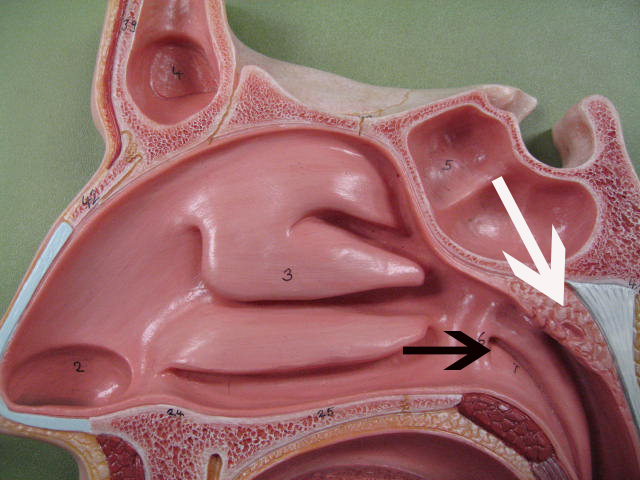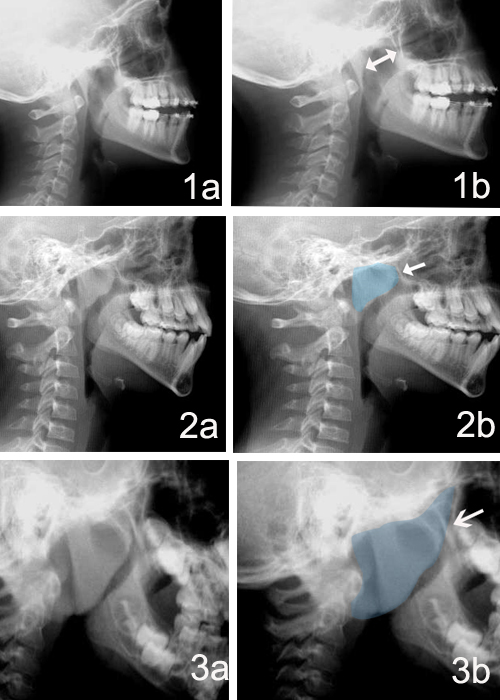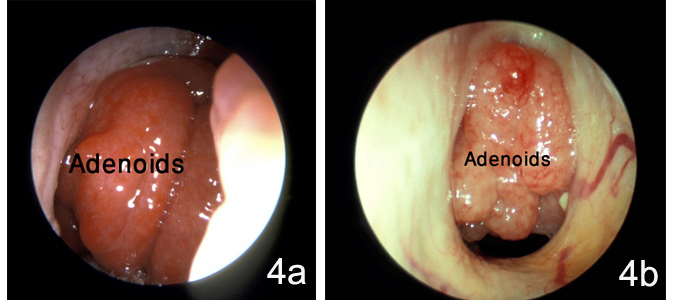Home / Throat and Voice / Adenoids
Adenoids
Call +65 8125 3580
for 24 by 7 appointment
What are Adenoids?
Nasopharynx or the post nasal space. Along with the tonsils which are located in the throat and are closely related to the adenoids, they are involved in fighting infection particularly in children. As the child grows older and the immune system evolves the function of fighting the infections by the adenoids and tonsilAdenoids (white arrow) are a patch of lymphoid tissue located at an area behind the nose called the s slowly ceases. Due to their location the adenoids are closely related to the Eustachian tubes openings (black arrow). The Eustachian tubes connect the nasopharynx with the middle ear and helps to equalise the pressure in the middle ear to that of the surrounding atmosphere. The x-rays show the normal nasopharnx (white arrow heads in Figure 1b). As the nasopharynx normally will have air it appears black on the x-ray. In Figure 2 a and 2b the adenoids are enlarged (shaded blue) and almost completely obstructing the back part of the nasal passage. In figure 3a and 3b the adenoids are very enlarged and completely obstructing the nasal passage.
Along with the tonsils which are located in the throat and are closely related to the adenoids, they are involved in fighting infection particularly in children. As the child grows older and the immune system evolves the function of fighting the infections by the adenoids and tonsilAdenoids (white arrow) are a patch of lymphoid tissue located at an area behind the nose called the s slowly ceases. Due to their location the adenoids are closely related to the Eustachian tubes openings (black arrow). The Eustachian tubes connect the nasopharynx with the middle ear and helps to equalise the pressure in the middle ear to that of the surrounding atmosphere. The x-rays show the normal nasopharnx (white arrow heads in Figure 1b). As the nasopharynx normally will have air it appears black on the x-ray. In Figure 2 a and 2b the adenoids are enlarged (shaded blue) and almost completely obstructing the back part of the nasal passage. In figure 3a and 3b the adenoids are very enlarged and completely obstructing the nasal passage.  Adenoids can become enlarged in children. As the child grows older with the growth of the facial skeleton the nasopharynx becomes larger. At the same time the adenoids start shrinking and by age 8-10 these almost completely disappear. In some children the adenoids may become so enlarged that they almost completely block the back part nasal passage. As a result the child is unable to breathe through the nose and resorts to breathing through the mouth. Enlarged adenoids may also block the Eustachian tube opening causing a negative pressure in the middle ear. Prolonged negative pressure in the middle ear may lead to fluid accumulation in the middle ear. With time this fluid can become thick quite akin to “glue” and hence the term, “glue ears”. Glue ears may cause significant conductive hearing loss as the sound now cannot be properly conducted through the ears. As a result of this hearing deficit, which may go completely unnoticed by the parents, the child may develop learning disabilities. This also may reflect in the child’s behaviour. Blockage of the back part of the nose, by the adenoids leads to accumulation of mucus within the nasal cavity. The mucus which is normally produced in the nose is cleared by being transported to the back part of the nose where it is swallowed. Prolonged accumulation of the mucus in the nasal cavity may cause infection and the child has a constant yellowish discharge from the nose. Sometimes the tonsils may be enlarged as well and the problem is compounded. Enlargement of both the tonsils and adenoids may lead snoring and blockage of the upper airway particularly when the child is sleeping. In some cases the child breathing may be so compromised so as to cause periods of “apnoea” where the breathing stops for periods of more than 10 seconds. This condition is called “Obstructive Sleep Apnoea” The diagnosis is established by a detailed examination which may include nasal endoscopy, (examination of the nasal cavity with a flexible endoscope) and oto-endoscopy, (examination of the ears with an endoscope.
Adenoids can become enlarged in children. As the child grows older with the growth of the facial skeleton the nasopharynx becomes larger. At the same time the adenoids start shrinking and by age 8-10 these almost completely disappear. In some children the adenoids may become so enlarged that they almost completely block the back part nasal passage. As a result the child is unable to breathe through the nose and resorts to breathing through the mouth. Enlarged adenoids may also block the Eustachian tube opening causing a negative pressure in the middle ear. Prolonged negative pressure in the middle ear may lead to fluid accumulation in the middle ear. With time this fluid can become thick quite akin to “glue” and hence the term, “glue ears”. Glue ears may cause significant conductive hearing loss as the sound now cannot be properly conducted through the ears. As a result of this hearing deficit, which may go completely unnoticed by the parents, the child may develop learning disabilities. This also may reflect in the child’s behaviour. Blockage of the back part of the nose, by the adenoids leads to accumulation of mucus within the nasal cavity. The mucus which is normally produced in the nose is cleared by being transported to the back part of the nose where it is swallowed. Prolonged accumulation of the mucus in the nasal cavity may cause infection and the child has a constant yellowish discharge from the nose. Sometimes the tonsils may be enlarged as well and the problem is compounded. Enlargement of both the tonsils and adenoids may lead snoring and blockage of the upper airway particularly when the child is sleeping. In some cases the child breathing may be so compromised so as to cause periods of “apnoea” where the breathing stops for periods of more than 10 seconds. This condition is called “Obstructive Sleep Apnoea” The diagnosis is established by a detailed examination which may include nasal endoscopy, (examination of the nasal cavity with a flexible endoscope) and oto-endoscopy, (examination of the ears with an endoscope.

Nasal endoscopy: Figure 4a and 4b. In the endoscopic examination in figure 4a the nasal passage is completely blocked by the adenoids. In figure 4b it is almost completely blocked. A plain x-ray of the nose will show the enlarged adenoids.( Figures 2 & 3) A hearing test may be required if fluid in the middle ear is suspected. The condition can be completely reversed by removing the adenoids. The operation is called adenoidectomy. The child will start to breathe through the nose and will stop snoring. The nasal mucus will now be normally cleared from nose and the excessive nasal discharge will cease. If the child has “glue ears” as well this will need to be sucked out by making a small incision on the ear drum. As Eustachian tube function may take some time to recover even after the removal of adenoids, in some cases small tubes are placed in the ear drum to equalise the pressure between the middle ear and the outer atmosphere. These are called ventilation tubes. After a few weeks having served their purpose these tubes will extrude from the ear. If your child has a blocked nose, nasal discharge, breathes through the nose, snores and has a suspected hearing problem, his adenoids may be the root cause of these symptoms.
What is adenoidectomy?

Adenoidectomy is an operation done to remove the adenoids. It is a very common operation done in children though sometimes it is performed in adults as well. The surgery is performed under general anaesthesia. There are many ways to remove the adenoids. I will describe here my technique of performing this operation. The surgery is performed through the mouth. A Boyle Davies retractor is used to open the mouth wide. The retractor is locked in position. The soft palate is retracted using small tubes. A high definition camera which is attached to the eye piece of a 70 degree endoscope is introduced through the mouth to visualise the nasopharynx. The camera system provided an excellent view of the adenoids on a high definition 20 inch LCD monitor. The adenoids can now be removed under direct vision. A Coblator is used to remove the adenoids. The coblator provides excellent hemostasis during the surgery with very minimal blood loss. As the surgery is performed under direct vision, it is possible to do a more complete operation. At the end of the surgery hemostasis is secured with monopolar and bipolar diathermy. The surgery takes about 20 to 30 minutes. The child is then monitored in the recovery room for about half an hour and then in the ward for a few hours before being discharged.
What to expect after adenoidectomy?
Some pain and discomfort is common after adenoidectomy. Pain killers and antibiotics if necessary are prescribed. The child should be able to take soft diet on the same day or the next day. It is advised to avoid hot and spicy food for about 2 weeks. It may take up to 2-3 weeks for the healing to take place.
What are the risks?
Children usually tolerate the surgery very well. Apart from the risks of general anaesthesia there is a risk of infection and bleeding from the surgical site.
Outcome:
The surgery has an excellent outcome. Most parents are very pleased with the results. He child is able to breathe better, sleep better, has less ear infections or sore throats and has a much improved quality of life. They even perform better in school.
Not sure if an adenoidectomy is you? Speak to A/Prof Sethi to find out if this is the right treatment for you at +65 8125 3580. Or book an appointment with A/Prof Sethi for a consultation on your symptoms and treatment options.
